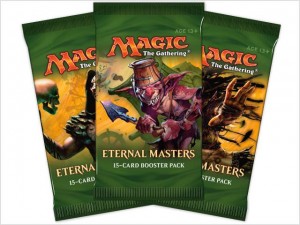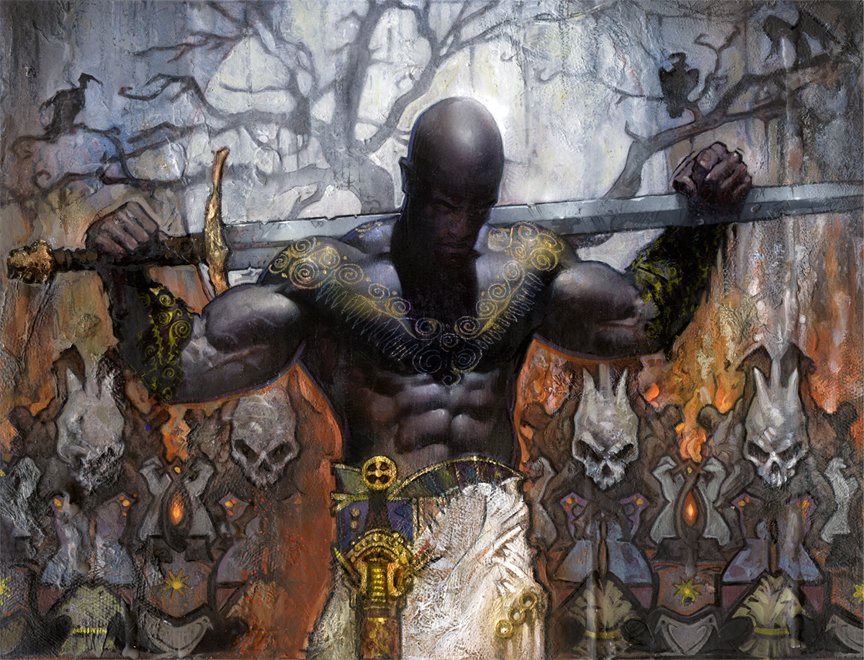Are you a Quiet Speculation member?
If not, now is a perfect time to join up! Our powerful tools, breaking-news analysis, and exclusive Discord channel will make sure you stay up to date and ahead of the curve.
At long last, Eternal Masters is here.

Who wants to draft?
This series is dedicated to helping you go infinite on MTGO through a combination of playing better and investing smarter. The past couple weeks our recommendations for picks before the release of Eternal Masters (EMA) have made strong gains. Our earlier picks, including Reserved List staples, are reaching maturity.
If you’ve been playing at home, you’ve amassed a nice war chest for drafting the new set. Investing is a nice way to cover costs, but ultimately we’re here to game.
Introducing Our EMA Draft Gurus
Today we start a two-part series on beating EMA draft alongside two draft gurus: Matthew Watkins and Bing Luke. They may not be household names on the pro circuit, but you don’t want to see yourself paired against these guys in the queues. Both are great at explaining their approach, and I can’t think of anyone better to guide us through a new format.

Matthew Watkins: Probably best known for his data-driven Ars Arcanum series at PureMTGO, Matthew has also been writing weekly “flashback” draft primers on the LRCast Subreddit. His ability to break down new draft formats is legend. In addition to being a “local end boss” in MTGO and paper, Matthew is a podcaster, storyteller, father, author, and educator.
Bing Luke: Bing is a three-time Magic Online Championship Series finalist, which means he has run the grueling MOCS gauntlet not once, not twice, but three times. He’s the only person to ever do so. He, like Matthew, is also a Community Cup competitor. When not mastering draft formats, Bing is an attorney and a certified Level 3 flavor judge.
I love new limited formats because they reward theory and experimentation rather than reps. I’m lucky if I draft twice a week, so I’ll never win the grind. Bing and Matthew will help us uncover overlooked cards and strategies that can pick up some wins before the format is solved.

It’s a good thing, too, because EMA drafts are going to be expensive. It will be hard to find more than a draft or two at your local game store. Most drafting will take place on MTGO, where it will be available for three weeks on demand.
Based on the EV projections—which will drop further once drafting starts—I’d estimate each draft will cost upwards of 10 tix for a player of average skill. There’s a lot of variance there, but on MTGO only two cards (Wasteland and Force of Will) are worth more than the cost of a draft.
Unless you have a strong feel for the format I recommend the phantom drafts. The Sealed decks are decent value as well. That said, there will be few better feelings on MTGO than taking down an EMA 8-4.
Assessing Individual Cards
Today, in Part 1 of the series, we will focus on individual cards in each of the five colors. What are the key shifts in rarity, and do they hold the key to the format? What cards will be underrated because they are unfamiliar or find themselves in a favorable context?
Tomorrow, in Part 2, we will tackle the ten two-color pairs and highlight other strategies that involve more than two colors.
Before we launch into a card-by-card analysis, it’s worth noting that the power level of this set is extremely high. As Matthew put it,
There are basically no bad commons in the set except for Tidal Wave. Everything else is a powerful card slated for a particular archetype or an important potential sideboard card like Fog (which will be important against the R/W Tokens matchup). When I saw Swords to Plowshares at uncommon that immediately signaled to me that WotC was not going to be pulling their punches with this set.
Rareshifted Cards
Speaking of not pulling punches, Wizards once again used rareshifts to enable particular approaches and archetypes. In parsing Vintage Masters (VMA), Modern Masters (MMA) and Modern Masters 2015 (MM2), one of the keys was understanding the rareshifts. They usually provide a signpost to where the development team is trying to lead us.
Here’s what they shifted this time:
From rare to uncommon
From uncommon (or rare) to common
I asked Bing and Matthew about the rareshifts and was somewhat surprised by Matthew’s response.
“I honestly think that the rarity shifts aren't that important for drafters to focus on. Sometimes they indicate card that WotC was trying to push, especially to make an archetype more consistent or powerful. But a lot of the time the rarity shift was made simply because the card was printed at the incorrect rarity the first time.
Havoc Demon, Emmessi Tome and Battle Squadron just wouldn't cut it at rare any more. Similarly, Glacial Wall, Tidal Wave, Night's Whisper, Carbonize, Roots, and Sylvan Might just wouldn't seem that out of place in a modern limited format.”
That said, Matthew picked eight cards where the rareshift really stood out to him:
- Phryexian Ingester at uncommon is clearly a move to make the U/B Reanimator archetype more powerful. In Vintage Masters, you had a couple of mediocre green creatures to reanimate, and the archetype sucked because of that. But when you're bringing back a giant Nekrataal, that's going to make an impact.
- Mesa Enchantress is key for the white-green deck. I think that the W/G Enchantment deck in general is going to be one of the worst archetypes, simply because you have three first-pick quality bounce spells in the format. Mesa Enchantress allows you to get back the cards you spend on auras, which allows you to compete.
- Sprite Noble is going to really surprise people. It's a three-mana 2/2 flyer that automatically makes you much more capable of blocking with your flyers, but also allows you to quickly put on the pressure in a game.
- Rally the Peasants at common is going to be miserable to play against. In general, I think the R/W Tokens deck is going to be overplayed and often weak, but when you cast and flashback a Rally, it's going to feel absurdly broken.
- Warden of Evos Isle at common is a huge deal, especially because it allows you to immediately turn on your five-drop flyers like Peregrine Drake, or even cast another Warden plus a Phantom Monster on turn four.
- Desperate Ravings at common is huge deal for the blue-red deck. In a deck that wants things in the yard, Ravings is so much better than Think Twice. This is going to be a very important role player.
- Elvish Vanguard at common is a huge deal. It used to be a strong rare. Now, you're going to dump it on turn two, and it'll be a 4/4 or 5/5 in no time.
- Sylvan Might is a much more powerful pump spell than we are used to (besides Confront the Unknown which spoiled us in Shadows over Innistrad). The trample bonus is so much more important than it seems, and sometimes getting the card for free off of milling yourself will be a big game.
For Bing, rareshifts played a bigger role.
"We'll certainly see once people have had a chance to draft the format, but a lot of my thoughts of the format are based on the rarity shifts. The cards that immediately stand out are Orcish Oriflamme, Elvish Vanguard, Sylvan Might, Elephant Guide, Elite Vanguard, Mistral Charger and Rally the Peasants. Also, Coalition Honor Guard isn't a rarity-shift per se, but it's a card that has no right to be printed at common, so take that for what it's worth."
Context is Everything
The set features ten two-color pairs. We’ll dig deeper into these in Part 2, but be sure to keep these in mind since synergies play an important part in the set. I’m going to use the ten archetype descriptions from Marshall Sutcliffe’s article on the mothership (though, as we’ll discuss tomorrow, it’s not clear these capture what each color pair does best).
- W/U Flying Matters
- U/B Reanimator/Recursion
- B/R Sacrifice
- R/G Fast Aggro
- GW Enchantments
- W/B Enters-the-Battlefield Effects/Blink
- U/R Flashback/Retrace
- B/G Elves
- R/W Tokens
- U/G Threshold
Color by Color
Next, let's look at the commons and uncommons from each color. Pick orders will depend on archetype and context, but I’ll mention some cards that caught my eye, as well as those Bing and Matthew see as especially key. (Tell me in the comments what I got wrong!)
I always find that when I take out those distracting rares and mythics and break down a set list visually by common and uncommon it's a clarifying exercise. Let's go for it:
White Commons
White Uncommons
Every color is deep, but white seems especially redundant. The commons all trend aggressive except for Second Thoughts and Honor Guard. Get used to reading these creatures sideways, since they'll spend a lot of time in the horizontal position.
My first picks, for what it's worth, are Pacifism and Kor Hookmaster. Pacifism has never not been first-pickable, and it has nice synergies in the green-white deck. Hookmaster is a huge tempo boost; I've heard him described as the white Man-o'-War, and he's exactly what you want to be doing in white.
Bing’s first impression is that, “looking at the commons cards, white looks like the strongest color by far, and has the commons that can support a deck regardless of whatever else you are doing. White-red aggro and blue-white fliers at first seem like the best use of those overpowered commons.”
“The first thing I noticed is that Coalition Honor Guard is included at common, which is messed up. There are really, really, really, really few common answers to it, and I'm not sure people remember how dumb flagbearers can be. I’m not sure Coalition Honor Guard is the best white common, but it's something that's interesting and it's going to be strange that every white deck will have access to one.”
Many of white’s uncommons are synergy-driven: Field of Souls, Honden, Intangible Virtue, Enchantress, Soulcatcher and Wall of Omens are near-unplayable outside of the right deck. But they’ll be powerful in their home.
Matthew was not as impressed by white. As we'll hear tomorrow, the U/W Flyers deck may have wings, but he's going to focus on other strategies...
I asked him for an underrated common and uncommon in each color, so I'll be listing those for each.
Shelter --- This is one of the best combat tricks of all time. It’s a trick that beats other tricks, protects your creatures, allows you to push damage through, and do all kinds of cool stuff, but that also draws you a card.
Wall of Omens --- This card is always pretty decent since it’s a two-for-one, but it’s also going to be very important for the W/U Flyers deck. It comes down on turn two, before most of the flyers, and holds the fort while you attack with flyers. It’ll be a high priority in the deck.
Blue Commons
Blue uncommons
Blue gets Matthew’s nod for the third most powerful color. Matthew's picks for the underrated players:
Shoreline Ranger – A 3/4 flyer for 6 is really unexciting, but this one is going to be pretty good in a variety of decks. Islandcycling is great because it allows you to keep so many more hands, while still giving you a powerful body in the late game. The cool part is that it slots in very well with all the blue archetypes: in white-blue it will often cost 5 mana instead of 6; in blue-black it cycles and then you can reanimate it for cheap or just have a good target for Gravedigger; in blue-red and blue-green it gets you closer to threshold.
Wonder – A 2/2 flyer for 4 is decent, but this card becomes great because your opponent just really can’t trade with it. The decks where this really seems amazing are U/R Tempo and U/G Threshold, both of which will be milling themselves some amount, and both of which will really be looking to give their aggressive creatures mass evasion.
My picks for top blue commons are Man-o'-War, Silent Departure, and Warden of Evos Isle. Deep Analysis and Phantom Monster are super powerful, but might be too slow.
Black Commons
Black Uncommons
Matthew's underrated picks for black are:
Carrion Feeder – The biggest problem with the R/B Sacrifice deck is that there aren’t enough ways to sacrifice creatures that give you an advantage, but Carrion Feeder fills that niche very nicely. The sacrifice ability costs no mana, so you can play the red echo creatures, get their effect, and then sacrifice them and still get the counter. It plays well with tokens and with morbid, so Wakedancer becomes a pretty potent card as does Tragic Slip. It’s one of the best ways to turn on Dragon Egg, and it turns Keldon Marauders into a great creature. The black-red decks are going to revolve around how many Carrion Feeders you can get.
Victimize – This is a tricky card to use and to set up, but it’s likely to be one of the most important role players in the format. Combining it with enters-the-battlefield creatures allows you to generate a lot of value. In the white-black deck, it gives you a sort of blink spell that can make that value strategy kind of work. In blue-black it reanimates your Phyrexian Ingesters and Man-o'-Wars. In black-red it allows you to sacrifice an echo creature and get back a Phyrexian Rager and a Nekrataal. In black-green it even allows you to grind through Civic Wayfinders and possibly even Regal Force. The setup is still pretty high, but I think the payoff will be worth it.
I personally think Carrion Feeder might flat-out be the best common in black. So many synergies. Eyeblight's Ending is a versatile removal spell, and Tragic Slip will be great in black-red since morbid will be easy to trigger.
Red Commons
Red Uncommons
Bing says,
Red looks very strong as well. The aggro decks look like they have a high ceiling.
[While not a high pick,] Orcish Oriflamme is also an interesting card. It's a card that does strange things in multiples. Rally might just be better though.
It's very strange for me to think of cards like this as commons. They are going to steal some games, but other times will be dead.
Matthew's underrated picks for red are Stingscourger and Keldon Champion:
Stingscourger – This was one of the best commons in Planar Chaos, and that set didn’t have as many synergies with Stingscourger. It’s going to be an important card in all of the decks, getting something out of the way so that other tempo decks can close out the game, while also providing a body that can be recurred in the black or white decks.
Keldon Champion – Again, echo is interesting in this set because the red-black deck can sort of ignore it and just sacrifice it, while the green-red and blue-red decks will occasionally get value out of just letting the creature die to fuel threshold, and the white deck can potentially bounce it with Whitemane Lion. This isn’t the best uncommon in red, but it will be a powerful card that people might not value highly enough.
For me, Firebolt is the best red common. I think the format will be tempo-oriented and being able to take out your opponents early drop and come back for more is huge. It also has synergies with Burning Vengeance, which we'll discuss tomorrow as a lynchpin of red strategies.
Green Commons
Green Uncommons
Both Matthew and Bing saw green as strong. Matthew thinks it might be the best color in the format, while Bing preferred white but felt that, “Green looks like it is the most safe. It has traditionally solid cards like Civic Wayfinder and Elephant Guide at common that give a lot of flexibility.”
I like Green because it can either play the aggressor role, go midrange, or serve as the foundation for powerful multi-color decks (which we’ll discuss tomorrow). And Elves can be a nice archetype that will sometimes dominate if they are open. My pick for top common, in a vacuum, is Werebear, but I don't know how strong threshold will turn out to be. I suspect Nimble Mongoose will be overrated because it's a house in Constructed.
Matthew's underrated picks are:
Civic Wayfinder – This is an elf, which helps the black-green deck, but it also fixes and gets you card advantage. Wayfinder has been a premium common every time it’s been printed, and I expect it to continue to be amazing here.
Timberwatch Elf – This is one of the best uncommons in the set. When it was first printed, it was common, but it was still stronger than most of the rares. In this set, it’s going to be the uncommon that really puts the elf archetype above the competition. Once this thing is active, you just win every combat, and often you can just push through for the win in a turn or two.
Multicolor Uncommons
No multicolor commons. The uncommons are all super powerful, and a third or fourth pick will usually signal that color pair is open.
Colorless Commons
Colorless Uncommons
Not much to see here in the lower rarities. You’ll play every Mishra's Factory you pick up---don't forget it blocks as a 3/3, but not on the turn it's played. Most artifact fixing comes at uncommon, so I suspect it will be hard to go multicolor unless you are green. I have a feeling Pilgrim's Eye will be a key role player in slower decks, providing a speed bump while fixing mana.
~
I hope this has whet your appetite! Next week we'll be digging in to specific archetypes. Drop a line in the forums if you disagree and let us know what your top uncommon and common is in each color.
-Alexander Carl
@thoughtlaced





